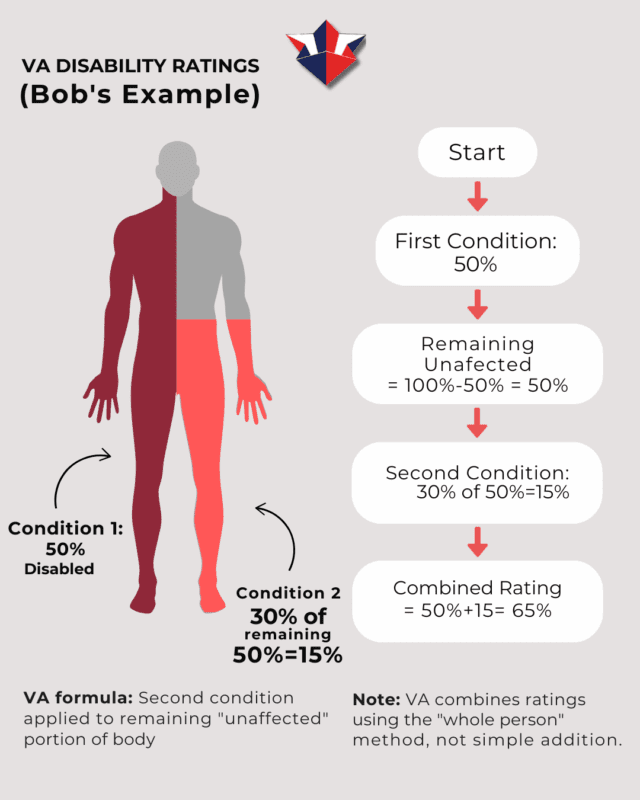Understanding VA Math: Why Your Ratings Don’t Add Up & How VETCOMM US Helps
Here at VETCOMM US, we’re built by veterans, for veterans—so we know how frustrating it is when all of your ratings aren’t adding up. The answer lies in something known as VA math, a calculation method that confuses nearly every veteran who encounters it. In this blog, we’ll break down how your ratings are combined, why they often seem lower than expected and how VETCOMM US helps you navigate the process with clarity, strategy and confidence.
What is VA Math?
Let’s start with the basics—what even is VA math and why is it notoriously confusing? It’s largely because it uses a complex system to combine multiple disability ratings. Instead of simply adding percentages together, the VA applies a descending scale to calculate your overall rating, which affects your monthly compensation and benefits eligibility.
Both primary and secondary service-connected conditions factor into this calculation. Understanding how VA math works is important because even small increases, when filed strategically, can push you past key thresholds—such as moving from 90 percent to 100 percent
The 90% Trap
Getting that final 10 percent isn’t usually as simple as adding one more condition. It takes a smart, strategic approach—finding related secondary conditions, making sure your medical evidence is thorough and filing your claims in the right way. This tricky situation is often called the “90 percent trap,” and understanding how to work around it can make a big difference in how much support and compensation you get.
How the VA Determines Your Overall Rating
You’ve submitted your claim, but you still haven’t reached your desired rating? You’re not alone. Many veterans are surprised when their total disability rating ends up being lower than expected. That’s because the VA doesn’t use simple addition to combine multiple conditions. Instead, they apply a calculation based on what’s called the “whole person” approach, a method designed to reflect how much of your body remains "unaffected" by service-connected disabilities.
Example:
Say Bob has a 50% disability rating for one condition. Later, he’s awarded 30% for another condition. Rather than just adding 50 and 30 to get 80, the VA calculates it like this:
- Bob starts with 100% of a whole, unaffected body.
- His first condition takes away 50%, leaving 50% unaffected.
- The second rating (30%) is then applied only to that remaining 50%, which equals 15%.
- So, 50% + 15% = a combined rating of 65%.
- The VA then rounds to the nearest 10
This “whole person” system often causes frustration, especially for veterans expecting a simple total. Even with multiple highly rated conditions, the combined rating may not increase as much as you think. That’s why knowing how the system works and planning your claims strategically can be key to moving from one benefits tier to the next.
Note: This method is based on the VA’s internal Combined Ratings Table, as outlined in the VA’s official regulations under 38 CFR § 4.25. For official information, visit www.va.gov.

How Primary and Secondary Claims Affect Your VA Rating
A primary claim refers to a direct service-connected disability, meaning the condition was caused or aggravated by your military service. For example, a knee injury you got during active duty.
A secondary claim is a condition that results from or is worsened by an existing service-connected disability. For example, if that knee injury causes you to develop back pain, the back pain can be claimed as a secondary condition.
Understanding the difference is important because both primary and secondary conditions contribute to your overall disability rating, but they are claimed and documented differently. Properly identifying secondary conditions can help increase your total rating and benefits.
How to Identify Secondary Conditions
Identifying secondary conditions starts by paying attention to any symptoms that developed after your primary service-connected condition. It’s important to review your full medical history and look for patterns, especially new or worsening issues that appeared following your original diagnosis.
Some secondary conditions are commonly linked to primary ones. For example, PTSD is often connected to sleep disorders, migraines or even high blood pressure. A medical professional can help determine if these conditions are related and may provide a nexus letter to support your claim. For additional guidance, working with a professional claims service like VETCOMM US can ensure you identify all eligible conditions and file strategically to maximize your rating.
How VETCOMM US Helps
That’s where we come in. Our VA claims assistance guides you through the confusing jargon, paperwork and process every step of the way. We help you understand what to expect, coach you on clearly describing your symptoms and work with you to strategically document all necessary information—making sure your claim is built on a solid foundation to maximize your rating and benefits.
4 Steps to Success
1.Sign Up
Book a strategy call and start your hassle-free experience. After making your purchase, we will guide you through the process of filing your Intent to File. This initial step ensures you're set up with the right foundation for your claim.
2.Intent Filed
Skip the technical challenges of filing online. Our team will assist you in submitting your Intent to File from the comfort of your home. This step locks in your claim's effective date and prepares the ground for the official claim submission.
3.Claim Filed
You’ll meet virtually with a Claims Advocate who will help you complete and submit your VA claim. They ensure that your claim is accurate, fully supported with the necessary documents and submitted correctly to the VA.
4.C&P Exam Prep
We provide one-on-one preparation for each required Compensation & Pension (C&P) exam. This step is crucial for your success, as proper preparation will help you present your condition effectively, ensuring the best chance of success on your first attempt.
Ready to get rated? Don’t let the confusion and complexity stop you from getting the benefits you’re owed. Contact VETCOMM US today for personalized guidance and support.

